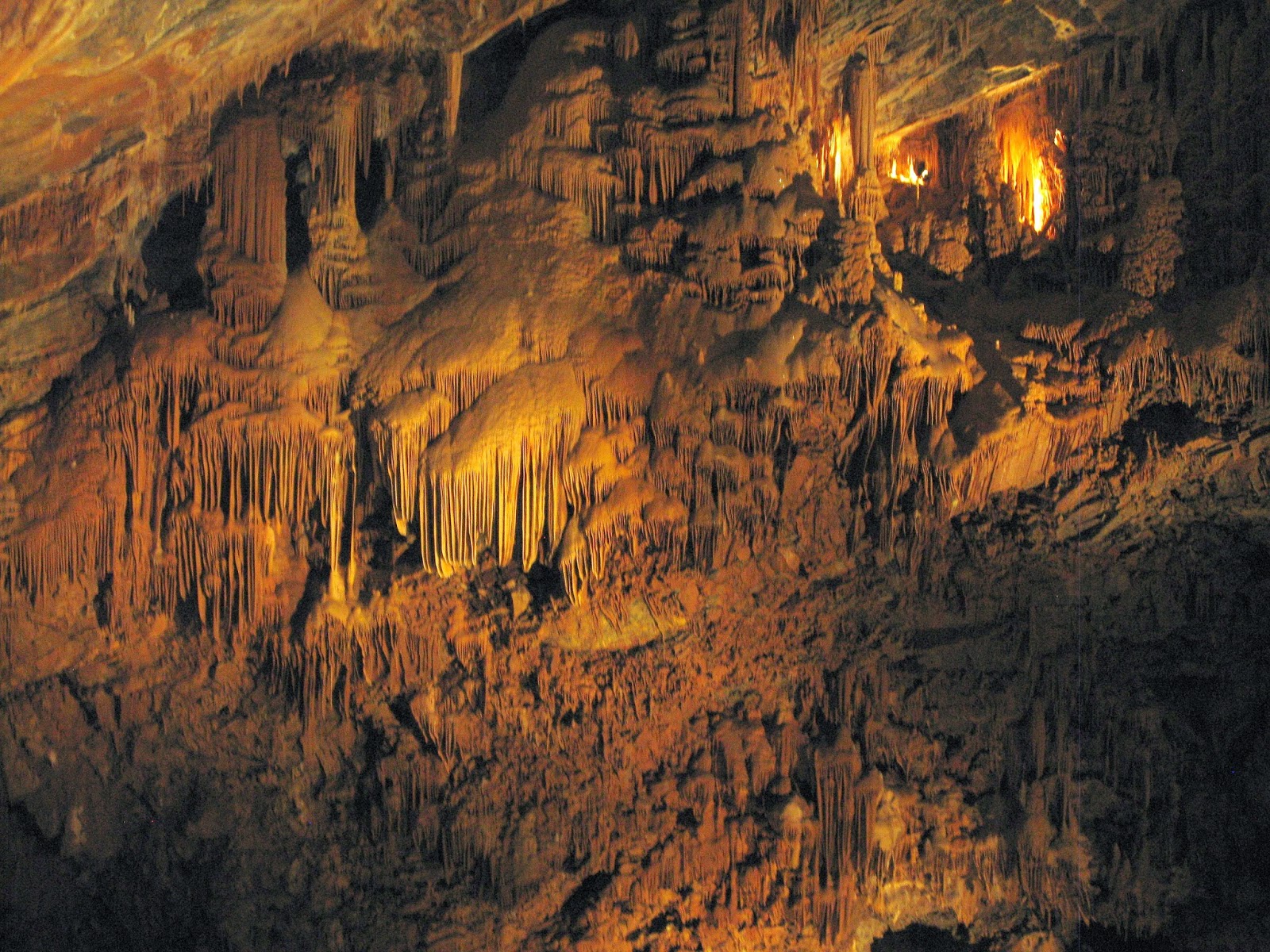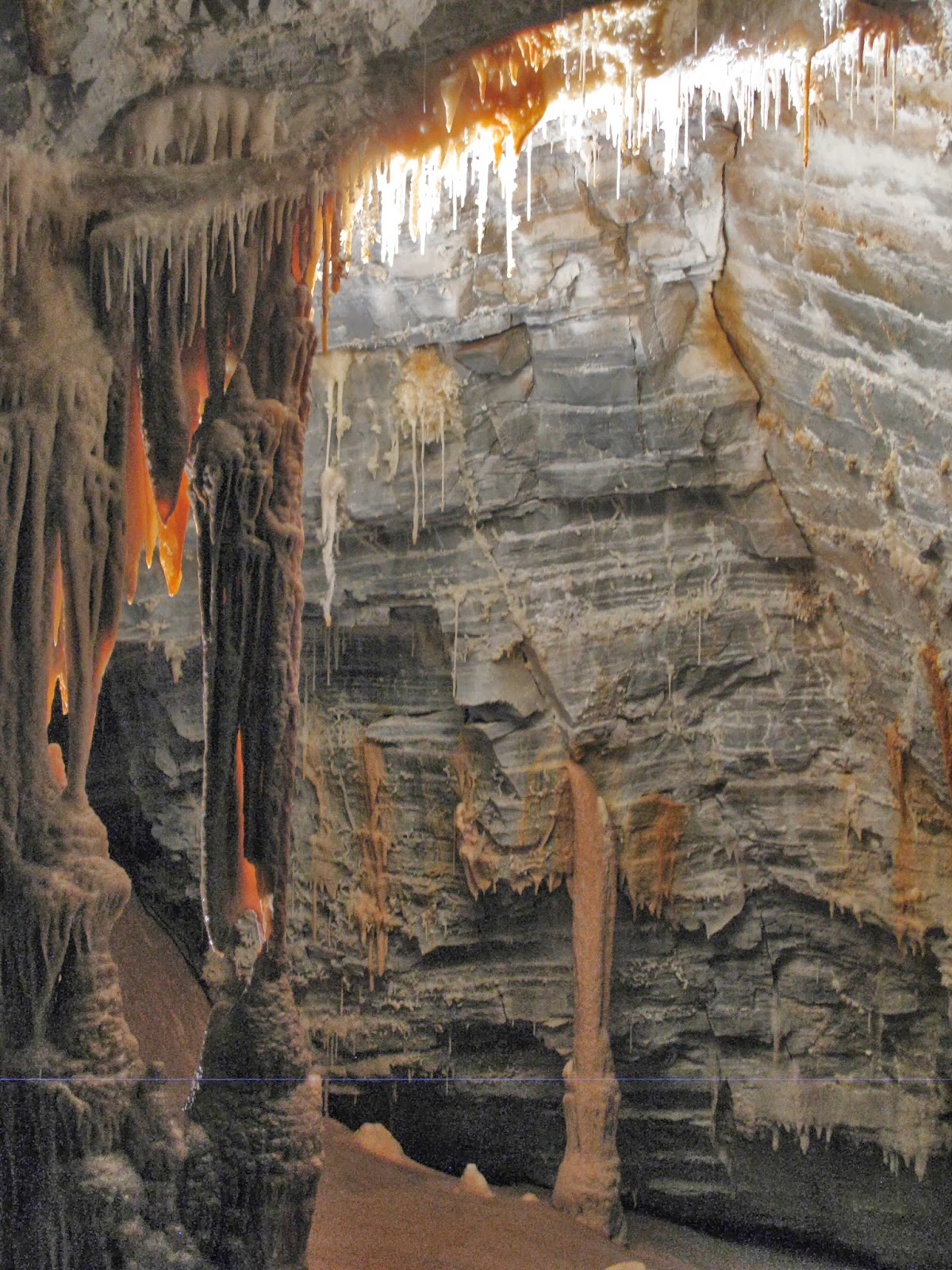The "Gouffre Géant de Cabrespine" is a giant cave unlike anything I've ever seen! Found by 3 young boys 45 years ago when they saw a bat flying out of a fissure in the ground, avid spelunkers* have been busy ever since probing into the depths of this cave to discover its many secrets. There is a river that runs along the bottom, joining this cave with the "Grotte de Limousis", also very popular with visitors to the area. *(A spelunker is one who explores cave systems.)
A "gouffre" is usually a cave with vertical significance whereas a "grotte" has horizontal significance.
I am standing at the edge of the parking lot to the Gouffre. Looking down the valley gives me an idea of the depth of the Gouffre.
Imagine a giant mushroom, with an immense bulb at the top, narrowing down to a stem at the bottom where the river flows. That's how I would describe Cabrespine. There are stalactite and stalagmite, crystallized aragonite, drapes, columns, cascades - an abundant and complete array of formations known the world over. You don't feel claustrophobic because of the impressive dimensions of the cave: 250 meters (820 feet) tall by 80 meters (262 feet) across, almost deep enough to contain the Eiffel tower.
There are walkways and balconies where you can stop to appreciate the grandeur and beauty as well as the geological interest. It is truly spectacular!
It is easy to breathe with no noxious gases. Unlike some caves, we are all walking upright and have no need to hunch down for any passages. Incredible feeling as though you've been dropped into another world.
We visit the cave on a guided tour that lasts about 45 minutes. The temperature is a constant 14 degrees, winter and summer, and very humid.
We come in from the top of the cave so we can look down rather than strain our necks looking up. At the main entrance of the cave at the bottom, we are told that some 30,000 bats come in to winter there. I didn't see one, but with Hallowe'en right around the corner, it might have been appropriate. There were some stuffed plush bats for sale in the boutique.
Towards the end of the tour, they put on a light show to the music of the opera "Carmina Burana", highlighting the formations that look like sculpted art. There is also a demonstration on how the current spelunkers are getting down to the floor of the cave.
This is a mannequin, but it looked very scary to go down to those depths attached to a rope. Our guide told us that most accidents occur with spelunkers who are very experienced, when this sort of activity becomes second nature and they don't take as many precautions. Newbies check and recheck their equipment and go cautiously, thus avoiding accidents.
This chair was displayed in the lobby, so I presume it is a sample of some of the chairs that have been used in the past to get up and down.
The Gouffre Géant de Cabrespine is unusual as a tourist destination and an experience not to be missed.
***
The vineyard fall colours, afar and close-up.
***
The museum "La Maison de la Truffe" covers all aspects of truffles, including its cycle throughout the year, with December being the start of truffle season when the hunt begins.
These are some of the tools used to pick the truffles: probes, digs, knives, and bags to hold the prized fungi.
Michelin chefs provided some of their best truffle recipes, including this chocolate mousse.
Preserving truffles is a delicate process, but it can be done through canning, freezing, or integrating the truffle into some other carrier, like honey and oil.
There was a whole section on mushrooms, also a fungus, and the identification of what is safe or poisonous to eat.
A real interesting "sniff" section where you can press a button and get to smell a range of truffles. Some are much stronger and more pungent than others.
Pigs and more often dogs are used to sniff out the truffles at the base of trees. The enemies of truffle hunters would be those animals who also dig for the truffles, and then eat them. The wild boar does that. These fungi are worth their weight in gold, so these losses are significant.
***
A quick drive through Lastours. Some buildings are old, but the four châteaux of Lastours are much older.
Located at an altitude of 300 meters, these châteaux proudly overlook the Orbiel river and the Grésilhou torrent. The walls, barbicans, square towers and keep perfectly illustrate the evolution of medieval military architecture.
***
We finished our touring day with dinner at L'Anaïs, a bar-restaurant in the heart of Ginestas run by Joanna and Christopher, the "Anglais" couple. This was our fifth visit to the restaurant, including one pizza take-out evening, and it's perhaps after this many visits that you realize what a gem it truly is. Consistent in its food preparation and presentation, we are never disappointed.
The period décor evokes paintings by Renoir and Lautrec, and on warm fall evenings, it's a pleasure to sit on the large, shaded terrace and be transported to a genteel time when men wore chapeaux and women had bustles and carried parasols.
So clean and inviting. Nothing decrepit about this place.
We've tasted many things on the menu, but this evening we started with a muscat for Karl and a Kir maison for me. There were field berries soaking at the bottom of my crémant which became very potent!
I had the chicken in a mushroom sauce, lying on top of creamy mashed potatoes. The chicken was tender and the skin was crispy and flavourful.
Karl had the canard confit, the duck leg, in a rich sauce with some Basmati rice. Very moist.
I finished my menu fix meal with a crème brulée made to perfection.
Karl had meringue topped with a scoop of vanilla ice-cream with compote berries on top and scattered on the plate. Very attractive.
What comes to mind when describing this restaurant is generosity. When Joanna pours a drink, she fills it to the brim. Somehow, not measuring every drop is indicative of the philosophy that these owners bring to their restaurant. Portions are ample. Bread baskets get refilled quickly. A patron asks for information and phone calls are made to help out. Smiles and gentle conversation are always on the menu. L'Anaïs is more than just the local restaurant, it's a little gem that any town would be proud to have. Lucky Ginestas!






























































No comments:
Post a Comment